Standard Bedroom Sizes for Adults, Kids, & More
Author: Rick Worst | Editor: Omar Alonso
Review & Research: Jen Worst & Chris Miller
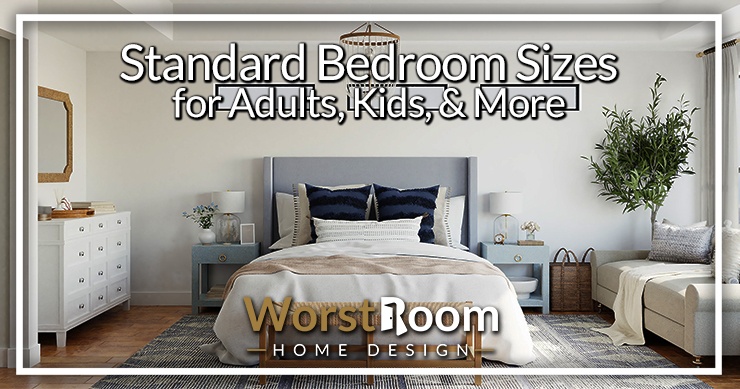
Choosing the right size bedroom can be daunting. You need a comfortable, functional, and not overstaffed bedroom to ensure a good night's rest. You also need a bedroom that's big enough to fit all the furniture and storage needs you have. But how big is big enough? Are there standard bedroom sizes?
The typically recommended bedroom size in the past is about 132 square feet (11 feet by 12 feet). However, due to increased bedroom furniture, modern homes are designed with larger master bedroom sizes of about 244 square feet. The additional space can allow users to accommodate larger furniture pieces.
Read on to learn more about the standard and average bedroom sizes, so you can make an informed decision when choosing your room size.
Standard Bedroom Sizes: Type, Legality, & More
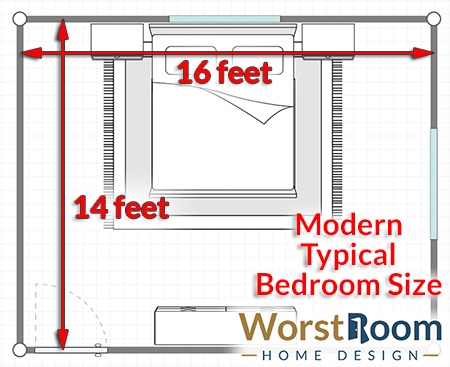
Bedrooms come in many shapes and sizes, according to users' needs and preferences. Smaller bedrooms are often used for children, while larger bedrooms become master suites where you can really dial in the bedroom feng shui.
As such, modern contractors are designing homes with large bedroom sizes to ensure better livability. The modern typical bedroom size, though, once you account for apartments, kid's rooms, and master bedrooms, is 14 feet by 16 feet.
Here is a brief analysis of some aspects of the standard sizes for bedrooms:
What Percentage of a House Do Bedrooms Floor Space Typically Take Up?
Traditional bedrooms occupy about 17% of the house's total area. The low percentage is due to minimal furniture pieces and the lack of niche walls or large windows. However, in modern constructions, the sizes can go up to 40% due to luxury furniture, fireplaces, and large windows.
As such, modern homes can have up to 2,600 square feet of bedrooms, while apartments have 941 square feet on average. The remaining percentage is shared between the living areas, bathrooms, kitchen, garage, and outdoor spaces.
The ratio can change depending on the property's size, design, and number of bedrooms in a building or house. For instance, when a property has more than three bedrooms, the percentage of total space increases.
How Many Bedrooms Do Homes Usually Have?
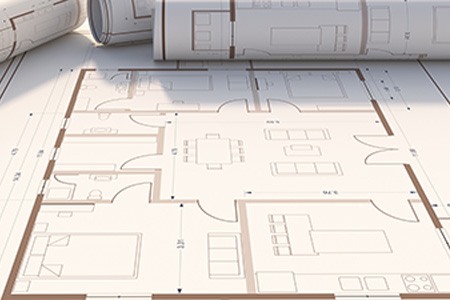
The number of bedrooms in a home depends on the total area and the homeowners' preferences. Most homes have three bedrooms or more to accommodate families with children.
For smaller homes, the number of bedrooms is usually two or one, while in some areas, they combine the bedroom with the living area.
Apartments have even fewer bedrooms, with most offering one or two rooms. However, in large apartments with multiple stories, the number of bedrooms can increase up to four or five, like a large independent home can.
Legal Requirements on the Size of a Normal Bedroom
Landlords and developers must follow specific legal requirements for a room to qualify as a bedroom. However, the conditions depend on the local regulations of a specific state. This reason is why there's a normal size of a bedroom at all. They all tend to opt for the minimum size, in apartments at least to increase the number of units per building.
Generally, each room should have a minimum size of 70 or 80 square feet to ensure a livable bedroom space. Though it varies, this is the generally accepted legal minimum across most states in the USA. However, this legal minimum size is often insufficient for numerous luxurious furniture pieces, but it can fit a standard bed and dresser.
The room must also have walls 7 feet apart, no matter the room's shape or design. This is part of the standard bedroom sizes requirements as a minimum. Also, each bedroom should have a large window for an emergency exit (which is why you don't want to put your bed in front of the window), a ceiling higher than 7 feet, and enough space for at least a standard depth closet to provide additional storage capacity.
Some states may provide an exemption to these requirements, such as when the bedroom serves as a multi-purpose room. They can also provide extra requirements for bedrooms to meet legal standards.
Average Bedroom Size Around the World
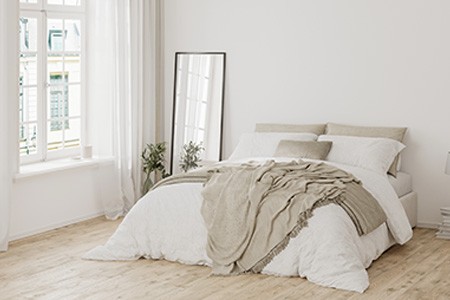
The average bedroom size is different worldwide. For example, on average, a bedroom in Australia is 103 square feet. In the UK, a bedroom size is 110 square feet on average, with the master bedrooms of course being a bit larger.
The difference stems from the bed size differences, where in some countries, the queen size measurements are lower than in other countries. The king-size measurements also differ.
For instance, a king-size bed in the US measures 76 by 80 inches, while in the UK, it is 72 by 78 inches. The difference can affect the room's size as the bed will occupy more space in the US than in the UK.
Average Sizes of House & Apartment Bedrooms
The average size of the house can influence the size of any other room, such as the bedroom, kitchen, and living area. Commonly, apartments tend to reduce the average room size due to the limited space.
On average, a one-bedroom apartment can measure about 100 square feet, while ins some cases, it can be up to 130 square feet. An average house can have a bedroom size of 224 square feet, while larger homes may have bedrooms that range from 250 to 300 square feet.
The difference is due to the extra space required for larger furniture, such as double beds and armoires.
Average Size of a Master Bedroom
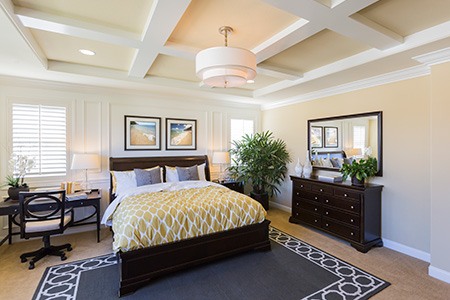
The master bedroom is the largest in a home and can range from 120 to 168 square feet. It is mostly the parent's bedroom and provides enough space for a queen or king-size bed. It can also offer extra space for an armoire, nightstands, a dresser, a couch, and an additional desk.
If the master bedroom is part of a larger suite, it can increase in size up to 224 square feet and even larger in the most luxurious homes, with a bathroom and walk-in closet included. The larger design can ensure more privacy and comfort for homeowners as they don't have to leave their bedrooms for any other rooms.
In upscale homes, interior designers can recommend the master bedroom have enough space to create a seating area, an office desk, and any other furniture choice.
Average Kid's Bedroom Size
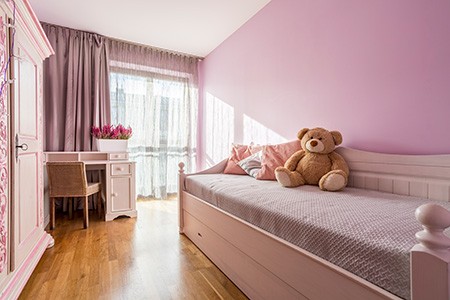
Children mostly sleep in standard bedroom sizes (meaning the smallest you can get away with mostly) with a twin bed, a dresser, and a desk. The twin bed allows two or more children to share the same room without feeling cramped. Consequently, it can help them develop a tight friendship, share toys, and make up games, which can benefit their emotional development.
The room can range from 80 to 160 square feet, depending on the size of the house and the available space. If more than one child is sharing the bedroom, the size may increase to ensure enough space for everyone. You can also adjust the furniture pieces to fit the bedroom and maximize the available space.
Average Dorm Room Size
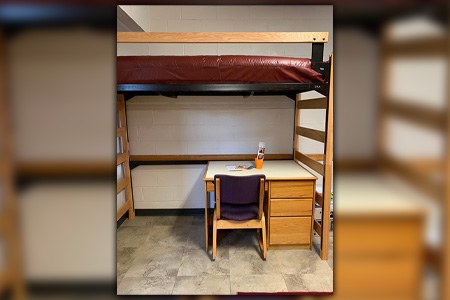
More than one college student mostly occupies a single dorm room. The room is built larger than regular bedrooms to ensure adequate space to fit multiple beds, desks, and dressers. The room size is an average of 228 square feet.
The room includes a common area with an extra-long twin bed, a desk, and a dresser for each student. A bathroom can also be included in the room if the college allows it. If not, students have to share the common bathroom down the hall with other students.
The dorm size may vary depending on the college's regulations and available space. Consequently, students in older dorms can find themselves in smaller rooms, while those in modern buildings tend to have larger and more comfortable dorms.
Average Hotel Room Size
A hotel room should provide guests with comfort, privacy, and convenience. For this reason, hotel rooms come in larger sizes of about 300 square feet. However, this depends on the hotel's star rating and location.
Five-star hotels tend to have larger rooms with amenities such as a king-sized bed, a couch, a desk, and a mini-fridge. For lower-class hotels, the room size can be up to 200, with a twin bed, a small table for two, and smaller bathroom amenities.
FAQ's Regarding Standard Bedroom Sizes
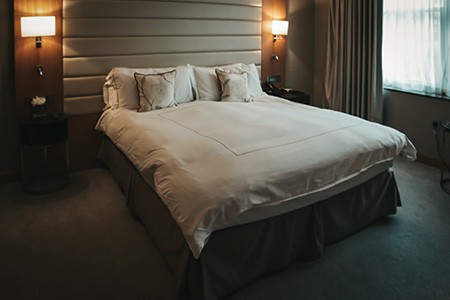
A comfortable and spacious bedroom can help you relax and sleep peacefully. However, knowing the exact size that fits your needs and preferences can be difficult. Here are some common questions related to bedroom size:
How Much Space is Decent for a Bedroom?
A decent sized bedroom should have enough space to comfortably fit a bed, dresser, and desk as a minimum. It should also provide enough privacy for the occupants, whether that be from one another in the same room or between rooms.
Is a 10’ by 10’ Bedroom Too Small?
A 10' by 10' bedroom is considered too small, especially if you share it with more than one person. However, you can still make the most of the space by investing in small furniture that can fit the size, maximizing it for two or more occupants. Items like bunk beds can help save a lot of space. The dimensions of an average bedroom are 14' by 16' to compare.
How Much Room Do You Need for a Bed?
The room size depends on the bed type you get, as different types of mattresses have varied sizes. For instance, a twin bed requires approximately 40 square feet of rectangular space, while a queen-size needs 80 square feet.
Here are the dimensions of the most common mattress sizes, and add a handful of inches in both directions for the frame and headboard:
- Twin: 38" x 75"
- Full: 54" x 75"
- Queen: 60" x 80"
- King: 76" x 80"
- California King: 72" x 84"
It's not just about the square footage but the actual shape of that footage and where it can or will be placed in your room. This is why rearranging furniture was always so fun as a youngster. Not only is it a puzzle but an optimal placement can create a lot more space for you in your bedroom.
What's the Average Bedroom Size? Is There a Standard?
The size of a bedroom can vary depending on its purpose and location. An average house has bedrooms of about 132 square feet, while apartments may have smaller bedrooms. However, a master bedroom can have an increased range of about 120 to 168 square feet. There is no standard, only a minimum required size of around 70 square feet.
It is essential to check the available space before investing in furniture pieces, as the size can determine what kind of bed, dresser, and other amenities you can fit. The standard bedroom sizes can also play a vital role in setting the ambiance, as a larger room can allow you to create a seating area or an office desk.



